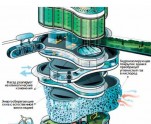Design 2050

By 2050, the human population will have reached 9 billion, 75% of whom will be living in cities. Until then, climate change, resource scarcities, rising energy costs and a preoccupation with preventing and minimizing the effects of the next natural or man-made disaster will undoubtedly shape our vision of the built environment. As major cities reach their boundary limits; extending transit networks and patterns of urban sprawl will no longer provide an effective solution. Instead, demographic and lifestyle changes will serve as major catalysts in the shift towards an increase in dense urban environments. As the city living takes center stage, what will we come to expect from the design and function of urban structures and buildings? Research Center and consulting company of Arup – Foresight + Innovation, studying the development of the built environment and society, offered their vision of the building of the future.
“Net-native” Generation
2050 will mark a generation of netnative adults who will have lived all their lives engaging with smart devises and materials. They will have experienced technological breakthroughs that will redefine how human beings interact – not only with each other, but with their surrounding environment. We will live in cities where everything can be manipulated in real-time and where all components of the urban fabric are part of a single smart system and an internet of things. These expectations set the tone for an environment that invites adaptation with ease; a place where hard infrastructure, communication and social systems are seamlessly intertwined, with a conscious necessity to integrate and engage in sustainable design practices.
Future technology will be far more focused on producing unique solutions for individual people.
This necessity for our surrounding environment to inherently understand an individual’s preferences and personal needs means all facets of the building network could respond to the specifics of each unique user – down to an individual’s genetic composition. In 2050, the urban dweller and the city are in a state of constant flux – changing and evolving in reaction to emerging contexts and conditions. The urban building of the future fosters this innate quality, essentially functioning as a living organism in its own right – reacting to the local environment and engaging with the users within. A dynamic network of feedback loops characterized by smart materials, sensors, data exchange, and automated systems that merge together, virtually functioning as a synthetic and highly sensitive nervous system.
In this sense, the building’s structure is highly adaptive and characterized by indeterminate functions; a scheme, where space and form is manipulated depending on the time of day or the user group currently activating it. The system presents a spatial and formal condition which is under constant change. A structure whose components are designed to be dynamic, intelligent and reactive – a living network activated by interaction with the users and its surrounding environment. Structural systems merge with energy, lighting and facade systems to extend beyond the confines of physical limits, and to shape a new type of urban experience
Full content of this issue you can read here
The full version of the article can be read in our printed issue, also you can subscribe to the web-version of the magazine
 Materials Provided By Arup
Materials Provided By Arup


